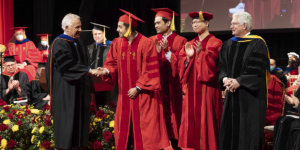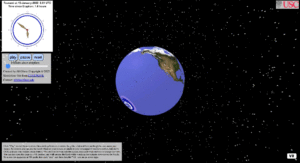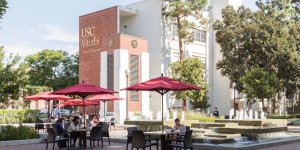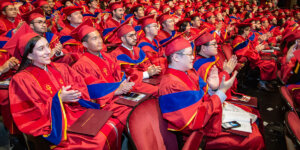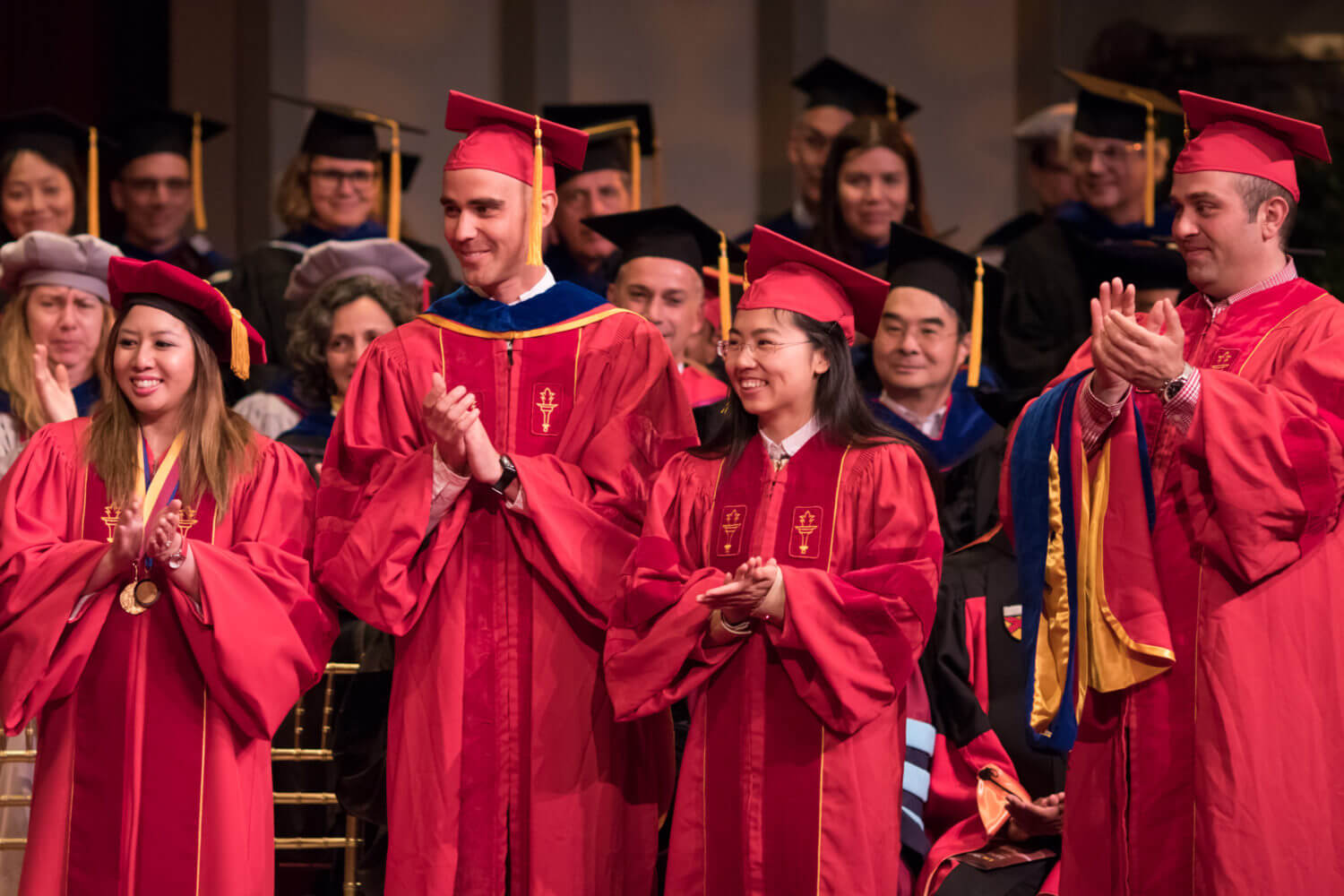
From left to right, the finalists of the 2017 best dissertation award – the William F. Ballhaus, Jr. Prize for Excellence in Graduate Engineering Research: Mary Gertrude Gutierrez; Nikos Kalligeris; Fei Fang; and Hooman Abediasl. Photo by: Victor Leung
Please click here if you wish to see a photo album of the ceremony.
Last June, Fei Fang took her first ride on the Staten Island Ferry.
She was one of about 66,000 passengers that day, boarding one of the five, orange ferries going from Manhattan to Staten Island. Nearby, in the waters of Upper New York Bay, she could see two small patrol ships with M240 Bravo machine guns.
What Fang knew – that the other 66,000 passengers didn’t know – was that it was her algorithm, guiding where those patrol ships would go, that was key to keeping them all safe.
Today, after five years of Ph.D. research, Fang was awarded the best USC Viterbi dissertation award for 2017 – the William F. Ballhaus, Jr. Prize for Excellence in Graduate Engineering Research.
At the 2017 USC Viterbi Ph.D. Hooding and Awards Ceremony, Dean Yannis C. Yortsos congratulated Fang and scores of newly hooded Ph.D.s. The May 11 event at USC’s Bovard Auditorium was the culmination of a half-decade or more of immersive research in topics ranging from tsunamis, socially assistive robots and biological imaging.
As Yortsos noted: “You will join a very select few: According to the most recent U.S. census data, just over 1 percent of the U.S. population holds a Ph.D. One of them, by the way, is a fellow by the name of Andrew Viterbi, who 50 years ago created the Viterbi Algorithm – the “killer app” behind digital communications, voice recognition and DNA sequencing among others.”
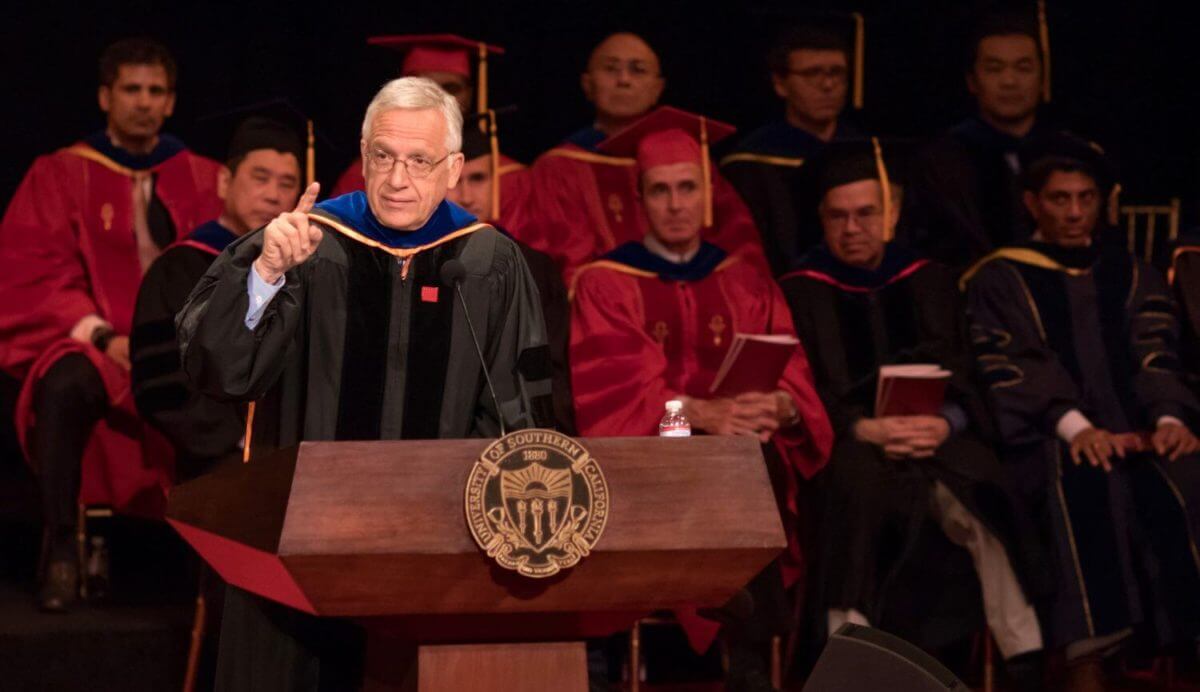
Dean Yannis C. Yortsos speaks at the 2017 USC Viterbi Ph.D. Hooding and Awards ceremony. Photo by Victor Leung
2017 Commencement PhD Video from USC Viterbi on Vimeo.
For Fang, who worked alongside Professor Milind Tambe in USC Viterbi’s Teamcore Lab, she feels fortunate to see her research having real world impact in security and sustainability: aiding the U.S. Coast Guard and even protecting endangered tigers in Malaysia.
In a world with limited security resources – whether it’s Coast Guard ships, U.S. air marshals, police or park rangers fighting poachers – Fang explored how best to deploy them. In the case of the Staten Island Ferry, the two Coast Guard patrol ships – vigilant of a U.S.S. Cole style attack – cannot be everywhere at once, and additional vessels cost upwards of $1 million. Unlike, say LAX, where Tambe’s lab also schedules security patrols, the Coast Guard is protecting five moving targets across one of the busiest waterways in the world.
Nevertheless, the Coast Guard has been impressed. Said Fang, “Professional mariners said that there is an apparent increase in U.S. Coast Guard patrols – even though they have the same number as before.”
For Fang, who begins a new life this fall as an assistant professor at Carnegie Mellon University, she felt a surge of pride that day aboard the ferry: “When the patrol boats did a sudden U-Turn, deep in my heart, I knew it was my algorithm at work.”

Fei Fang, winner of the the William F. Ballhaus, Jr. Prize for Excellence in Graduate Engineering Research. Her research has lead to improved Coast Guard security of the Staten Island ferries.
Nikos Kalligeris, Ph.D. ’16, another finalist for the best dissertation award, was born and raised in a coastal town in Crete, sailing the Aegean on a small dinghy and his father’s 34-foot boat, called Orizon.
Despite his lifetime love of the sea, he also learned a deep and abiding respect for the waves. Once, en route to a regatta with his father, Kalligeris encountered a terrible storm with 40-knot winds. They stubbornly refused to turn back, and the ship’s main mast paid the cost.
Under the direction of Professors Patrick Lynett and Costas Synolakis in the USC Coastal Engineering Group, Kalligeris studied even more powerful waves – tsunamis. Specifically, the tsunami induced currents and eddies that wreak havoc on ports. Consider the story of the Maersk Mandraki, a 285-meter freighter moored to the port of Salalah in Oman. Following the 2004 Indonesian mega-tsunami, the Maersk Mandraki was torn free, spinning out of control for several hours. Miraculously, it avoided collision with other ships and harbor structures, but it dramatized the impact of even distant tsunamis. The 2004 tsunami originated over 3,000 miles away – near the Indonesian island of Sumatra – but it underscored the potential danger to say, the California coastline, from events like the 2011 Tōhoku earthquake and tsunami.
In his Ph.D. dissertation, entitled “Tsunami-induced turbulent coherent structures,” Kalligeris studied the the generation and evolution of tsunami-induced eddies. The experimental and analytical results of his research may provide insight on how these eddies affect our coastal infrastructures and make harbors in tsunami-prone areas safer in the future.
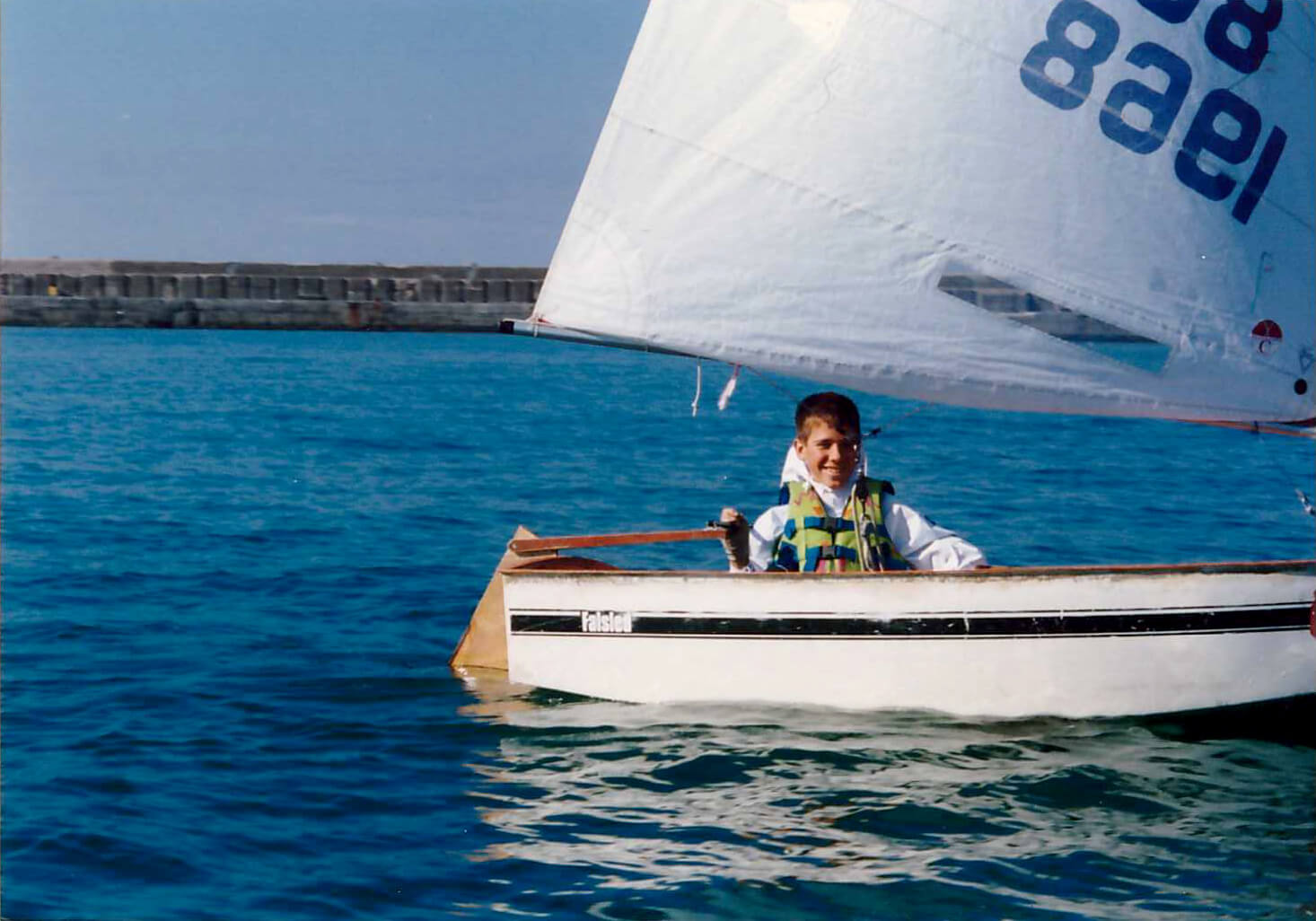
Nikos Kalligeris, age 14, off the coast of his native Crete.
As Yortsos noted to the 161 newly minted Ph.D.s: “The world is being re-created and re-imagined, like never before – with an astonishing speed, at an exponential pace, in front of our very eyes. And it is engineers and visionaries like you and your work that drive this re-imagination.”
Here are the 2017 winners of important Ph.D. awards:
BEST DISSERTATION
Department of Aerospace and Mechanical Engineering
Yangyang Huang
Analyzing the Aerodynamics and Stability of Lambda-flyers in Oscillatory Flows
Department of Biomedical Engineering
Yu Chen
Spectral Domain Optical Coherence Microscopy for Label-free Biological Imaging
Mork Family Department of Chemical Engineering and Materials Science
Mary Gertrude Gutierrez*
Engineering Artificial Cells to Elucidate GPCR 5-HT1AR Activity and Plasma Membrane Compositional Dependence
Sonny Astani Department of Civil and Environmental Engineering
Nikos Kalligeris*
Tsunami-induced Turbulent Coherent Structures
Department of Computer Science
Fei Fang**
Towards Addressing Spatio-temporal Aspects in Security Games
Ming Hsieh Department of Electrical Engineering
Hooman Abediasl*
Integrated Large-scale Monolithic Electro-optical Systems in Standard SOI CMOS Process
Ren Chen
Optimal Designs for High Throughput Stream Processing Using Universal RAM-based Permutation Network
* finalist, William F. Ballhaus, Jr. Prize for Excellence in Graduate Engineering Research
** winner, William F. Ballhaus, Jr. Prize for Excellence in Graduate Engineering Research
BEST RESEARCH ASSISTANT
Department of Aerospace and Mechanical Engineering
Hanliang Guo
Department of Astronautical Engineering
Randall Scott Hughes
Department of Biomedical Engineering
Travis Peterson
Mork Family Department of Chemical Engineering and Materials Science
Renuhaa Asaithambi
Shanyuan Niu
Sonny Astani Department of Civil and Environmental Engineering
Ali Ghahramani
Jiachen Zhang
Department of Computer Science
Wolfgang Hoenig
Brandon Schlinker
Haifeng Xu
Amulya Yadav
JENNY WANG EXCELLENCE IN TEACHING AWARD
Lauren Crawford, Environmental Engineering Ph.D.
Roberto Martin del Campo Vera, Electrical Engineering Ph.D.
Olivia Evanson, Industrial & Systems Engineering Ph.D.
Wolfgang Hoenig, Computer Science Ph.D.
Shanie Liyanagamage, Biomedical Engineering Ph.D.
Qianru Qi, Petroleum Engineering Ph.D.
Edward Wagner, Mechanical Engineering Ph.D.
William Yu, Astronautical Engineering Ph.D.
Department of Aerospace and Mechanical Engineering
Edward Wagner
Department of Astronautical Engineering
William Yu
Department of Biomedical Engineering
Shanie Liyanagamage
Mork Family Department of Chemical Engineering and Materials Science
Qianru Qi
Sonny Astani Department of Civil and Environmental Engineering
Lauren Crawford
Department of Computer Science
Wolfgang Hoenig
Ming Hsieh Department of Electrical Engineering
Roberto Martin Del Campo Vera
Daniel J. Epstein Department of Industrial and Systems Engineering
Olivia Evanson
MING HSIEH INSTITUTE SCHOLARS
Ming Hsieh Department of Electrical Engineering
Yu Cao
Pradipta Ghosh
Erick Moen
Guodong Xie
Yihang Zhang
UNIVERSITY AWARDS
Student Recognition Award
Travis Peterson
Elaine Schaertl Short
Joycelyn Yip
Viterbi Undergraduate Research Mentoring Award
Si Shen
Elaine Schaertl Short
Published on May 12th, 2017
Last updated on February 10th, 2021




